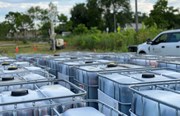In Pile Thermal Desorption® With the HB1100
By: CascadeRead this before your next Dig and Haul Project!
For sites with modest amounts of contamination - “modest” being defined as soil volumes between 2,000 to 12,000 cubic yards, and contamination defined as hazardous organic waste - the typical method for eliminating the liability and risks associated with that waste is to excavate the material, and then treat and/or dispose of it in a hazardous waste landfill.
The problem is that it often becomes cost prohibitive to transport contaminated soils for treatment or disposal, especially when the site is particularly far from such a facility or if the contaminants are recalcitrant, or co-mingled with various contaminant types.
For those who wish to treat their contamination on-site to required low treatment levels, your options are also limited. Traditional Thermal Desorption Units (TDUs) are better suited for larger volumes of soil, due to the cost to mobilize and operate the machinery. Soil mixing with chemical agents often return mixed results, and many times require multiple treatments over long periods of time (often years) in order to meet treatment objectives.
TerraTherm, Inc., an innovative Cascade company that specializes in In Situ Thermal Remediation (ISTR) technologies, identified these issues before creating the HB1100, a new product specifically designed for sites with modest volumes of contamination that require treatment for stringent remediation goals.
Introducing the Heated-Box, or HB1100:
The HB1100 is a configuration of TerraTherm’s patented In Pile Thermal Desorption® (IPTD®) technology which, like In Situ Thermal Desorption (IPTD), features the simple, robust, and highly effective heating method of Thermal Conductive Heating (TCH).
TCH has been applied for environmental remediation since the late 1980’s, treating Volatile and Semi-Volatile Organic Contaminants (VOCs and SVOCs respectively) to non-detect treatment levels. Since TerraTherm was founded in the year 2000, TCH has been used to successfully remediate over 50 sites worldwide, all with 100% success.
THE NAME
What does the name HB1100 actually mean? The “HB” stands for “Heated-Box,” and the first “1” represents the first iteration of Heated-Box technology in the market today. The “100” represents the 100 cubic yards of soil or sediment that each unit is capable of treating in each batch.
The Benefits
The HB1100 minimizes liabilities and risks associated with hazardous organic waste by eliminating the need for transporting and/or manifesting the waste. Plus, by treating contamination on-site, you are opting for a more sustainable approach for remediation.
It’s the innovative design of the HB1100 that allows us to deliver valuable benefits to our clients, helping them to save time, money and resources. The HB1100 was specifically designed with mobility in mind; capable of rapid deployment to spills or remediation projects with nothing more than standard tractor-trailer rigs. Additionally, on-site, plug & play equipment components allow for increased efficiency by reducing pre-design engineering efforts, construction and demobilization durations.
The HB1100 features centralized treatment equipment, which provides efficient utilization of both equipment and labor by treating batches in a sequential, staggered operation fashion (U.S. Patent No. 6,881,009). Plus, the HB approach was designed for scalability. Each unit can hold up to 100 cubic yards but multiple units can be deployed for larger treatment volumes and expedited schedules.
Above all else, the heating approach used in the HB1100 is robust and capable of treating even the most recalcitrant contaminants. It also eliminates much of the pre-treatment of materials and segregation processes that are known to hamper other on-site thermal remediation technologies.
Applications
The HB1100 is by no means a “silver bullet” for all remediation projects, but it is a niche technology well-suited for sites with shallow contamination. The HB1100 is also well-suited for:
- On-site treatment for IDW (e.g., drill cuttings);
- Corrective Action Management Unit (CAMU);
- Delisting RCRA waste codes;
- Emergency responses;
- Separating metals and organic contaminants;
- Treating CVOCs from comingled PCB (or other SVOC) contamination; as well as a,
- Supplemental technology for fixed hazardous waste facilities (in cases where they cannot take certain contaminants, the HB1100 can be used to reduce concentrations, treat soils, and segregate organics from metal contamination.
Conclusion: Why consider the HB1100?
The HB1100 is a patented, robust, and sustainable remediation technology. It’s capable of treating the entire range of organic contaminants, including both listed and characteristic Land Disposal Restricted (LDR) hazardous wastes to applicable clean up goals, in a fast, efficient, and safe manner.
Before you use Dig & Haul for your next remediation project, or if you would simply like to learn more about HB1100 and how it works, please contact Nate Bierschenk at Cascade Environmental.
Email: [email protected]

